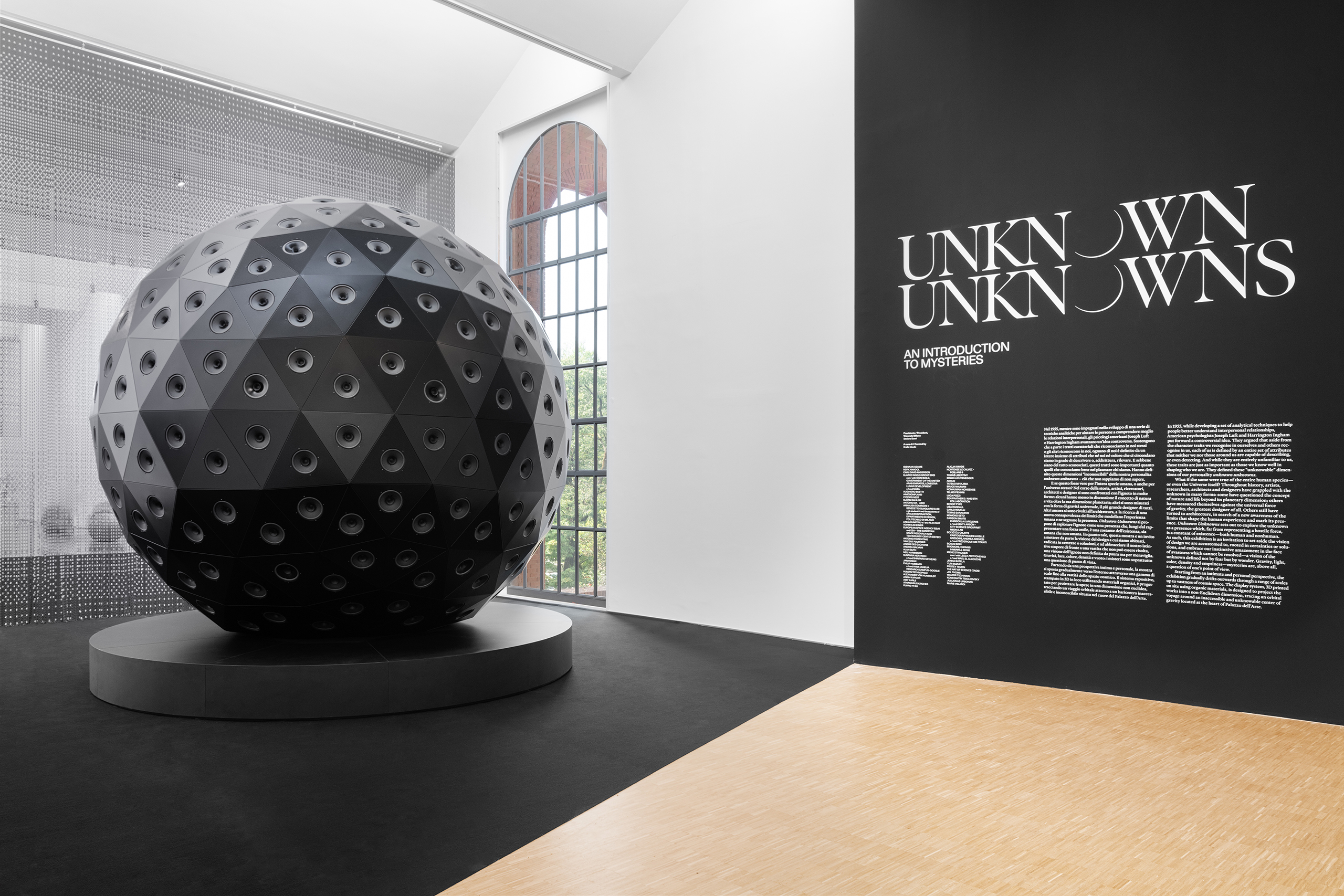Across glossy mosaic floors and past the hall where the exhibits of the 23rd International Exhibition of the Milan Triennale converge and merge, I climb a monumental staircase, leaving behind the 2000s-flavored interior bridge, and arrive at a somehow familiar yet unsettling welcome: a Death Star–ish disco ball with a steel-chain curtain backdrop, a multifaceted suspended solid made of audio speakers that gently moan multiple noises in all directions. I take a step back, pause, and let my inner David Byrne ask, “How did I get here?”
This space has long been a hybrid realm. It is called the Palazzo dell’Arte, but the institution it hosts does not spring directly from the realm of art. The origins of the Milan Triennale emerge from the interface between technological progress and an increasingly large consumer class—a dialogue between arts, crafts, and mass production similar to the Deutscher Werkbund, that most German of associations from which modern architecture as we know it developed. In its early days, the Triennale simply sought to display the fruits of this industrial production. But in 1964, it took a critical turn when philosopher Umberto Eco and filmmaker Tinto Brass used the Triennale to analyze the notion of “free” time. Nowadays, international exhibitions and their manifesto-laden main shows have further evolved into big questioning devices, as opposed to design exhibits. Or rather, they are now tools for design insofar as they manage to redefine its questions, to open its scope a little.

The central exhibit of this year’s Triennale, Unknown Unknowns: An Introduction to Mysteries, explores the difficult question of what we don’t know we don’t know, in an attempt to break us out of our human- and earth-centric ways of thinking and designing. Notably, the show is curated by an astrophysicist, Ersilia Vaudo, the chief diversity officer at the European Space Agency. “Unknown Unknowns focuses, through an intense dialogue between art, design, and science, on the need to move beyond an anthropocentric outlook, be it terrestrial or cosmic,” Vaudo told AN Interior. “To what extent is the presumption of anthropocentrism tied to claiming awareness as exclusive to us humans? The cosmic perspective is clear. We are granted no unique stature, much less a central role. In the words of the astrophysicist, writer, and poet Michel Cassé: ‘Science is a lengthy struggle against geocentricism and anthropocentrism, a gradual decentralization that causes some narcissistic pain, while others experience it as liberation and ecstasy.’”
Some of the exhibited works directly address the fact that humans are not the only designers on the planet: We are treated to Humboldt and Bonpland’s equinoctial plant geographies, which recall today’s nonhuman ethnographies; the holobiont that connects the universe with a bacterium in the digestive system; the architectures of bees and ants; the maps of terra forma that embrace a nonlinear time and disclose the possibility of another world; and a visualization of the imminent and inevitable merging of the Milky Way and Andromeda galaxies, which will happen sometime in the next four to five billion years in “a boundless, empty space admitting no sound.”

Other works trigger a more dialectical dimension. While BIG’s architecture for Mars echoes something Earth-based, right across the room is a display of research by SOM that explores the possibilities of an extraterrestrial architecture based on nonterrestrial conditions that have until recently been categorized as hostile. Meanwhile, Bruce Nauman’s Failing to Levitate in the Studio (1966) humorously reminds us that gravity is inescapable, while Julijonas Urbonas, in When Accelerators Turn into Sweaters (2021), shows us that sweaters knitted from superconductive fibers, when anchored above a magnet, can in fact levitate.
A dialectic is the perspective through which the cyborg universe has been addressed as well. We are treated to the amplification of human faculties into “superpowers” of perception through magnetoreception mindware and the possible development of new human cells in a bioreactor. This latter theme is memorably rendered in Amy Karle’s Regenerative Reliquary (2016), a scaffold in the shape of a human hand that is 3D-printed in hydrogel that disintegrates over time; it is meant to be seeded with human stem cells and grow into actual tissue and bone.

There is also a section dedicated to mathematics—“the possible … gateway to access what we do not know.” We are shown research, models, and fog chambers that intercept and make visible the passage of cosmic radiation. Tomás Saraceno’s Particular Matter(s) (2022) has also been adapted for the Triennale, where the illusory nature, quantity, and movement of particles suspended in our atmosphere are made knowable by the exactness of a net and the beam of light that intercepts it.
After visitors complete this loop through the unknown and reemerge into the hall, the Death Star–ish disco ball appears again, its role finally clarified. The installation by Yuri Suzuki, Sound of the Earth: Chapter 3 (2022), plays noises from around the world that have been submitted via a website (soundoftheearth.org). Stimulated by so many inputs, I’m overwhelmed by how noncentral and non-almighty (although quite harmful) human beings seem to be. Consequently, I also see how non-alone in a universal process of constant design and redesign we are. We stand listening, ready to see how far these thoughts can take us.
